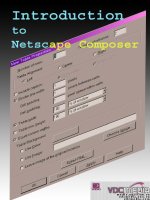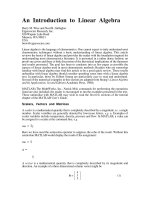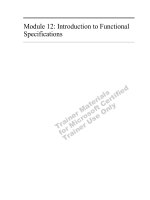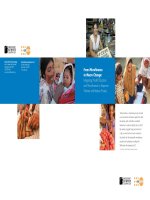Introduction to Health Education pdf
Bạn đang xem bản rút gọn của tài liệu. Xem và tải ngay bản đầy đủ của tài liệu tại đây (388.37 KB, 133 trang )
LECTURE NOTES
For Health Extension Trainees in Ethiopia
Introduction to Health Education
Meseret Yazachew
Yihenew Alem
Jimma University
In collaboration with the Ethiopia Public Health Training Initiative, The Carter Center,
the Ethiopia Ministry of Health, and the Ethiopia Ministry of Education
November 2004
Funded under USAID Cooperative Agreement No. 663-A-00-00-0358-00.
Produced in collaboration with the Ethiopia Public Health Training Initiative, The Carter
Center, the Ethiopia Ministry of Health, and the Ethiopia Ministry of Education.
Important Guidelines for Printing and Photocopying
Limited permission is granted free of charge to print or photocopy all pages of this
publication for educational, not-for-profit use by health care workers, students or
faculty. All copies must retain all author credits and copyright notices included in the
original document. Under no circumstances is it permissible to sell or distribute on a
commercial basis, or to claim authorship of, copies of material reproduced from this
publication.
©2004 by Meseret Yazachew Yihenew Alem
All rights reserved. Except as expressly provided above, no part of this publication may
be reproduced or transmitted in any form or by any means, electronic or mechanical,
including photocopying, recording, or by any information storage and retrieval system,
without written permission of the author or authors.
This material is intended for educational use only by practicing health care workers or
students and faculty in a health care field.
i
Acknowledgment
The development of this lecture note for training Health Extension
workers is an arduous assignment for Dr. Meseret Yazachew and
Dr. Yihenew Alem at Jimma University.
Essentially, it required the consolidation and merging of existing in
depth training materials, examination of Health Extension Package
manuals and the Curriculum.
Recognizing the importance of and the need for the preparation of the
lecture note for the Training of Health Extension workers THE
CARTER CENTER (TCC) ETHIOPIA PUBLIC HEALTH TRAINING
INITIATIVE (EPHTI) facilitated the task for Jimma University to write
the lecture note in consultation with the Health Extension
Coordinating Office of the Federal Ministry of Health.
Finally the Federal Ministry of Health would like to express special
words of gratitude for those who contributed and endeavored to the
development of this lecture note and to TCC/USAID for the technical
and financial support.
ii
Table of Contents
Content
Acknowledgement i
Table of content ii
List of abbreviations vi
List of tables vii
List of figures vii
Introduction ix
UNIT ONE: Introduction To Health Education
Objectives 1
Health Education 3
• Historical development 3
• Definitions 4
• Aims and Basic principles of Health Education 7
• Approaches to Health Education 10
• Targets for Health Education 10
• Health Education settings 11
• Who is responsible for Health Education? 11
• Role of Health Educator 12
Exercises 13
iii
UNIT TWO: Health And Human Behavior
Objectives 14
Introduction 14
Definition of behavior and other related terms 15
Factors affecting human behavior 17
The role of human behavior for prevention of disease 22
Exercise 25
UNIT THREE: Working With Communities
Objectives 26
Introduction 26
Definition of community 27
Concept of community participation 27
Benefit of community participation 30
Helping people to organize: The role of Health Extension
Workers 31
UNIT FOUR: Health Communication
Objectives 35
Introduction 35
What is communication? 36
Why communication? 36
Types of communication 37
iv
Components of communication 38
Communication stages 41
Common communication approaches 49
Methods of communication 49
Barriers to effective communication 51
Characteristics of effective communication 55
UNIT FIVE: Educational Methods And Materials
Objectives 57
Introduction 57
Educational methods 58
• Individual 58
• Group 63
Teaching materials 77
• Audios 77
• Visual aids 79
Mass media 84
Exercise 87
UNIT SIX: Training
Objectives 88
Introduction 88
What is training? 89
Types of training 89
Phases of training 89
v
Exercise 94
UNIT SEVEN: Planning, Implementation and Evaluation Of Health
Education Programs
Objectives 95
Introduction 95
Planning process 95
• Information gathering 97
• Defining and prioritizing problems 101
• Setting goals and objectives 103
• Identifying and obtaining resources 105
• Selecting appropriate methods 107
Carry out and evaluate the project 110
• Development and implementing a project plan 110
• Evaluating the project 111
Exercise 113
UNIT EIGHT: Ethical Issues in Health Education
Objectives 114
Introduction 114
Definition 114
Basic Principles of Ethics 115
Health extension workers responsibilities as a health educator .117
Exercise 119
vi
Reference: 120
vii
List of abbreviations
AIDS Acquired Immuno-Deficiency Syndrome
HE Health Education
HEWs Health Extension Workers
BCC Behavioral Change Communication
FGM Female Genital Mutilation
FP Family Planning
HIV Human Immunodeficiency Virus
HSDP Health Sector Development Program
IEC Information Education Communication
MOH Ministry of Health
PHC Primary Health Care
WHO World Health Organization
UNICEF United Nation Children’s Fund
viii
List of tables
Table 4.1 Examples of failure at different communication
• stages 47
Table 5.1.Main characteristics of mass media and face-to-face
communication 85
List of figures
Fig.2.1. Levels of prevention of disease 22
Fig.4.1. Complete communication model 38
Fig.4.2. Communication stages 42
Fig. 6.1 Project planning cycle 96
ix
Introduction
The impetus for writing this lecture note arose from two but
interrelated pressing demands. The primary reason is the
identification of community based health care approach, as a
strategy, by the MOH of Ethiopia which intern required the training of
Health Extension Workers (HEWs). In addition to the eight
components of HSDP identified during the 1
st
phase, HSDP II
included the training and deployment of HEWs who will be delivering
essential health care services at the grass root level. Reference
materials on health communication both as an aid for the training of
these groups of development workers as well as for future utilization
at the work places are scarce or absent so far.
Appreciating the critical necessity of this material, the Carter Center/
Ethiopian Public Health Training Initiative, requested Jimma
University to prepare and make it ready for the purpose.
Accordingly, the Department of Health Education & Behavioral
Sciences made utmost effort to produce the material within the
shortest time possible. We tried to include major topics on health
education and promotion taking into account the scope of the
beneficiaries and the essentiality of some titles. The first two chapters
deal with the concept and principles of health education and issues
related to health and human behavior. With the assumption that the
health extension workers are closely working with and for the
community, the general concept and ways of community participation
x
is described in the 3
rd
chapter. The fourth chapter discusses on health
communication.
Educational methods and materials are purposely discussed relatively
in a more detail in chapter five to provide adequate alternatives for
the HEW in their effort of communicating issues on disease
prevention and health promotion to individuals and families at
household level. The 6
th
and 7
th
chapter addresses planning process
of health education programs and designing training sessions,
respectively. Working with the community is something to be carried
out with caution. Therefore, ethical issues and standards are
discussed in the last chapter.
The authors believe that, though this lecture note is primarily
prepared for HEWs as a reference material, other paramedical and
related health educators can find it useful.
During the writing, we have tried our best to utilize simple and
understandable terms so as to make its consumption easier at all
levels. Examples and illustrations from personal experiences and the
work of other colleagues were used to make the material more
palatable. Objectives of each topic in every chapter are outlined to
help readers anticipate some knowledge before going through the
section. Study questions are also forwarded at the end of every
chapter to serve as a self-test. Lastly, we would be grateful and
enthusiastic to receive any sort of feedbacks and comments on the
writing.
1
UNIT ONE
Introduction To Health Education
Objectives
At the end of this chapter, the trainees will be able to:
• Explain the concept of Health.
• Define Health Education.
• State historical development of Health Education.
• Describe objectives of Health Education.
• State basic principles of Health Education.
Before discussing about health education, it is imperative to
conceptualize what health itself means. Health is a highly subjective
concept. Good health means different things to different people, and
its meaning varies according to individual and community
expectations and context. Many people consider themselves healthy
if they are free of disease or disability. However, people who have a
disease or disability may also see themselves as being in good health
if they are able to manage their condition so that it does not impact
greatly on their quality of life.
WHO defined health as “a state of complete physical, mental, and
social well being and not the mere absence of disease or
infirmity.”
2
Physical health – refers to anatomical integrity and physiological
functioning of the body. To say a person is physically healthy:
• All the body parts should be there.
• All of them are in their natural place and position.
• None of them has any pathology.
• All of them are doing their physiological functions
properly.
• And they work with each other harmoniously.
Mental health - ability to learn and think clearly. A person with good
mental health is able to handle day-to-day events and obstacles, work
towards important goals, and function effectively in society.
Social health – ability to make and maintain acceptable interactions
with other people. E.g. To feel sad when somebody close to you
passes away.
The absence of health is denoted by such terms as disease, illness
and sickness, which usually mean the same thing though social
scientists give them different meaning to each.
Disease is the existence of some pathology or abnormality of the
body, which is capable of detection using, accepted investigation
methods.
3
Illness is the subjective state of a person who feels aware of not
being well.
Sickness is a state of social dysfunction: a role that an individual
assumes when ill
Health Education
Historical development
While the history of health education as an emerging profession is
only a little over one hundred years old, the concept of educating
about health has been around since the dawn of humans. It does not
stretch the imagination too far to begin to see how health education
first took place during pre-historic era. Some one may have eaten a
particular plant or herb and become ill. That person would then warn
(educate) others against eating the same substance. Conversely,
someone may have ingested a plant or herb that produced a desired
effect. That person would then encourage (educate) others to use this
substance.
At the time of Alma Ata declaration of Primary Health Care in 1978,
health education was put as one of the components of PHC and it
was recognized as a fundamental tool to the attainment of health for
all. Adopting this declaration, Ethiopia utilizes health education as a
primary means of prevention of diseases and promotion of health. In
4
view of this, the national health policy and Health Sector
Development Program of Ethiopia have identified health education as
a major component of program services.
Definition
Health education has been defined in many ways by different authors
and experts. Lawrence Green defined it as “a combination of learning
experiences designed to facilitate voluntary actions conducive to
health.”
The terms “combination, designed, facilitate and voluntary
action” have significant implications in this definition.
Combination: emphasizes the importance of matching the multiple
determinants of behavior with multiple learning experiences or
educational interventions.
Designed: distinguishes health education from incidental learning
experiences as systematically planned activity.
Facilitate means create favorable conditions for action.
Voluntary action means behavioral measures are undertaken by an
individual, group or community to achieve an intended health effect
with out the use of force, i.e., with full understanding and acceptance
of purposes.
5
Most people use the term health education and health promotion
interchangeably. However, health promotion is defined as a
combination of educational and environmental supports for actions
and conditions of living conducive to health.
Various terms used for communication and health education
activities
Information, Education and Communication (IEC) is a term
originally from family planning and more recently HIV/AIDS control
program in developing countries. It is increasingly being used as a
general term for communication activities to promote health.
• Information: A collection of useful briefs or detailed
ideas, processes, data and theories that can be used
for a certain period of time.
• Education: A complex and planned learning
experiences that aims to bring about changes in
cognitive (knowledge), affective (attitude, belief, value)
and psychomotor (skill) domains of behavior.
• Communication: the process of sharing ideas,
information, knowledge, and experience among people
using different channels.
Social mobilization is a term used to describe a campaign approach
combining mass media and working with community groups and
organizations.
6
Health extension is an approach of promoting change through
demonstration, working with opinion leaders and community based
educational activities.
Nutrition education is education directed at the promotion of nutrition
and covers choice of food, food-preparation and storage of food.
Family Life Education refers to education of young people in a range
of topics that include family planning, child rearing and childcare and
responsible parenthood.
Patient education is a term for education in hospital and clinic settings
linked to following of treatment procedures, medication, and home care
and rehabilitation procedures.
Behavior Change Communication (BCC): Is an interactive process
aimed at changing individual and social behavior, using targeted,
specific messages and different communication approaches, which
are linked to services for effective outcomes.
Advocacy: refers to communication strategies focusing on policy
makers, community leaders and opinion leaders to gain commitment
and support. It is an appeal for a higher-level commitment,
involvement and participation in fulfilling a set program agenda.
7
Aims and principles of health education
Aims
• Motivating people to adopt health-promoting behaviors by
providing appropriate knowledge and helping to develop positive
attitude.
• Helping people to make decisions about their health and acquire
the necessary confidence and skills to put their decisions into
practice.
Basic Principles
• All health education should be need based. Therefore before
involving any individual, group or the community in health
education with a particular purpose or for a program the need
should be ascertained. It has to be also specific and relevant
to the problems and available solutions.
• Health education aims at change of behavior. Therefore
multidisciplinary approach is necessary for understanding of
human behavior as well as for effective teaching process.
• It is necessary to have a free flow of communication. The two-
way communication is particularly of importance in health
8
education to help in getting proper feedback and get doubt
cleared.
• The health educator has to adjust his talk and action to suit
the group for whom he has to give health education. E.g.
when the health educator has to deal with illiterates and poor
people, he has to get down to their level of conversation and
human relationships so as to reduce any social distance.
• Health Education should provide an opportunity for the clients
to go through the stages of identification of problems,
planning, implementation and evaluation. This is of special
importance in the health education of the community where
the identification of problems and planning, implementing and
evaluating are to be done with full involvement of the
community to make it the community’s own program.
• Health Education is based on scientific findings and current
knowledge. Therefore a health educator should have recent
scientific knowledge to provide health education.
• The health educators have to make themselves acceptable.
They should realize that they are enablers and not teachers.
They have to win the confidence of clients.
9
• The health educators should not only have correct information
with them on all matters that they have to discuss but also
should themselves practice what they profess. Otherwise, they
will not enjoy credibility.
• It must be remembered that people are not absolutely without
any information or ideas. The health educators are not merely
passing information but also give an opportunity for the clients
to analyze fresh ideas with old ideas, compare with past
experience and take decisions that are found favorable and
beneficial.
• The grave danger with health education programs is the
pumping of all bulk of information in one exposure or
enthusiasm to give all possible information. Since it is
essentially a learning process, the process of education should
be done step-by-step and with due attention to the different
principles of communication.
• The health educator should use terms that can be immediately
understood. Highly scientific jargon should be avoided.
• Health Education should start from the existing indigenous
knowledge and efforts should aim at small changes in a graded
fashion and not be too ambitious. People will learn step by step
and not everything together. For every change of behavior, a
10
personal trail is required and therefore the health education
should provide opportunities for trying out changed practices.
Approaches to health education
• The persuasion approach –deliberate attempt to influence
the other persons to do what we want them to do (DIRECTIVE
APPROACH)
• The informed decision making approach-giving people
information, problem solving and decision making skills to
make decisions but leaving the actual choice to the people.
E.g. family planning methods
Many health educators feel that instead of using persuasion it is
better to work with communities to develop their problem solving skills
and provide the information to help them make informed choices.
However in situations where there is serious threat such as an
epidemic, and the actions needed are clear cut, it might be
considered justified to persuade people to adopt specific behavior
changes.
Targets for health education
• Individuals such as clients of services, patients, healthy
individuals
• Groups E.g. groups of students in a class, youth club
• Community E.g. people living in a village
11
Health education settings
When considering the range of health education interventions, they
are usually described in relation to different settings. Settings are
used because interventions need to be planned in the light of the
resources and organizational structures peculiar to each. Thus, health
education and promotion takes place, amongst other locations, in:
• Communities
• Health care facilities
• Work sites
• Schools
• Prisons
• Refugee camps …etc
Who is responsible for health education?
Health education is the duty of everyone engaged in health and
community development activities. Health Extension Workers are
primarily responsible in working with the families and community at a
grass root level to promote health and prevent disease through
provision of health education. If health and other workers are not
practicing health education in their daily work, they are not doing their
job correctly. When treating someone with skin infection or malaria, a
health worker should also educate the patient about the cause of the
illness and teach preventive skills. Drugs alone will not solve the
12
problems. Without Health Education, the patient may fall sick again
from the same disease. Health workers must also realize that their
own personal example serves to educate others.
Role of health educator
• Talking to the people and listening of their problems
• Thinking of the behavior or action that could cause, cure and
prevent these problems.
• Finding reasons for people’s behaviors
• Helping people to see the reasons for their actions and health
problems.
• Asking people to give their own ideas for solving the problems.
• Helping people to look as their ideas so that they could see which
were the most useful and the simplest to put into practice.
• Encouraging people to choose the idea best suited to their
circumstances.
13
Exercise
1. Define health and health education?
2. Explain why voluntary actions are so important in health
education programs.
3. List health education settings found in your locality.
4. Mention five basic principles of health education.









